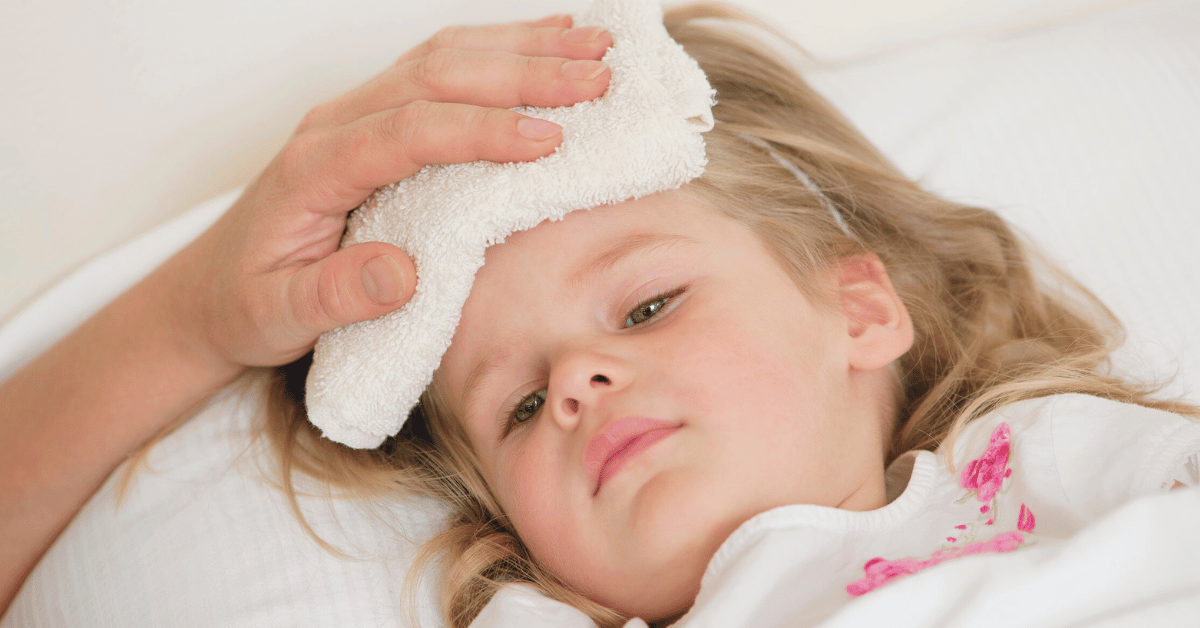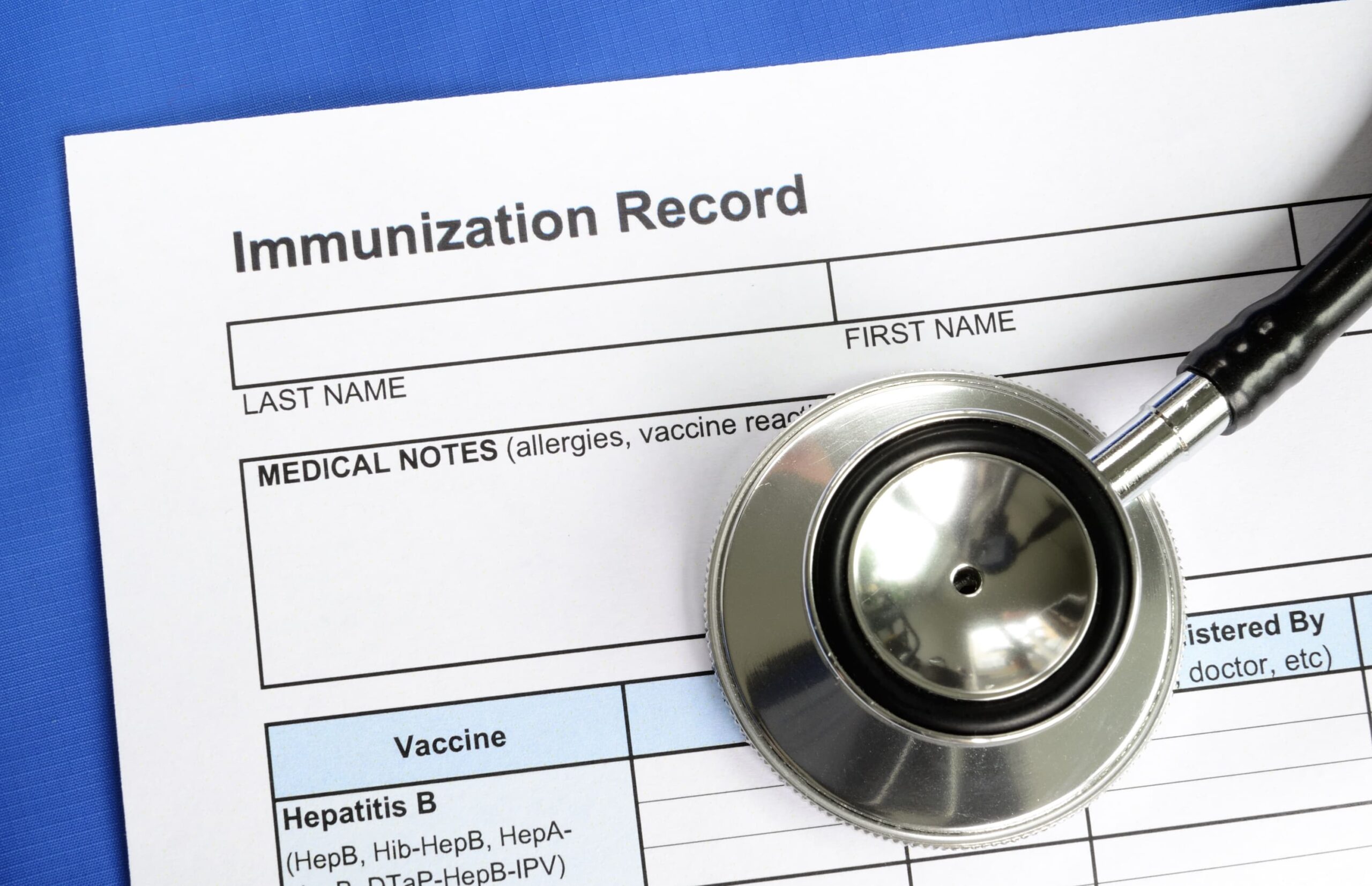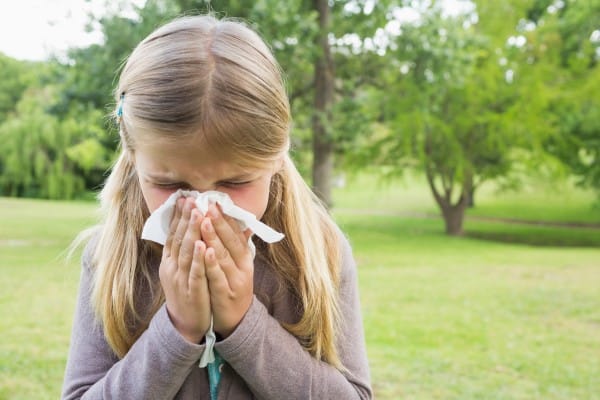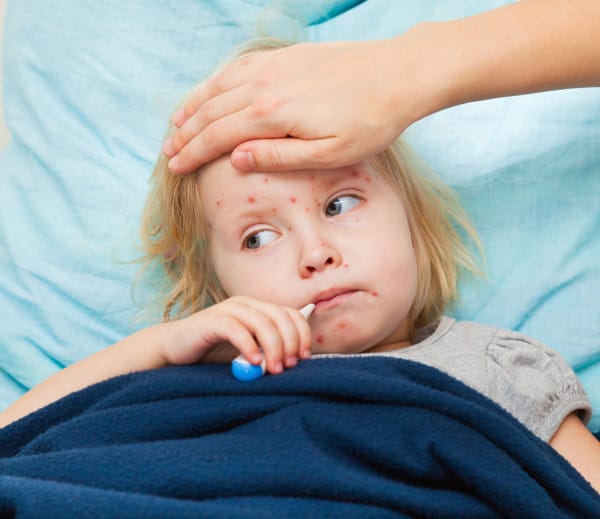For many parents, a child with a fever can be anxiety inducing, and it’s natural to want to reach for fever-reducing medications at the first sign of a temperature. In my practice, I like to remind parents that fevers are a natural and essential part of the body’s response to infection, signaling that the immune system is hard at work fighting off invaders.
In this article, you’ll learn about the potential benefits of fevers, as well as the potential causes for concern, such as febrile seizures. I’ll also provide guidance on home care strategies and when it’s important to call a doctor or to medicate.
What is a Fever, and Why is it Beneficial?
A fever is the body’s natural defense mechanism in response to infections caused by viruses or bacteria (1). When the immune system detects an invader, it signals the hypothalamus in the brain to increase body temperature (2). This rise in temperature helps to:
- Inhibit Pathogen Growth: Many viruses and bacteria thrive at normal body temperature. A higher body temperature creates a less favorable environment for these pathogens, slowing their ability to grow and spread (3).
- Boost Immune Response: Fever increases the production and activity of white blood cells, which are vital in attacking and destroying invaders (1).
- Promote Healing: Fever facilitates healing by increasing blood circulation, delivering immune cells more efficiently to the site of infection (4).
Fevers are beneficial for mild to moderate infections and are often a sign that the body is taking appropriate action to fight off illness. However, there are certainly circumstances where fever management is necessary, particularly when it leads to other complications like febrile seizures or when it reaches certain thresholds (5).
You may also be interested in this article: Does My Child Get Sick Too Often? Understanding Sickness Frequency in Children
Home Care for Fevers: A Natural Approach
Supporting a fever at home can be as simple as providing comfort and ensuring that your child is hydrated and resting. Here are some holistic approaches:
1. Hydration
Fevers cause fluid loss through sweating, so it’s crucial to keep your feverish child well-hydrated. Offer small sips of water, herbal teas (like chamomile or peppermint), coconut water, or homemade electrolyte drinks. Breastfeeding infants should nurse frequently to maintain hydration. Staying hydrated also helps keep mucus thin and flowing.
To learn more about how to nourish the body during and after illness, read this article: What To Eat After An Illness To Rebuild Strength & Immunity
2. Rest
Encourage your sick child to get plenty of rest, as the body is using energy to fight off infections. Follow your child’s lead: if your child wants to get up and play, allow them to do so, but try to keep a calm environment conducive to resting.
3. Herbal Support
Herbs can gently support the fever process, without suppressing it. Choose herbs that encourage a balanced immune response and promote relaxation.
- Lemon Balm: Lemon balm calms the nervous system and helps reduce the restlessness or anxiety that can be experienced during fevers (6).
- Catnip: Catnip is a soothing herb that supports restful sleep and digestive comfort (7).
- Chamomile: Chamomile is a favorite for soothing irritability and promoting restful sleep (8), making it ideal for feverish children.
- Elderflower and Elderberry: Both elderflower and elderberry encourage a healthy inflammatory response and support the immune system (9). Elderflower is also a gentle diaphoretic (9), meaning it encourages sweating and may help regulate body temperature.
Herbs can be given as herbal glycerites or teas, or added as essential oils to a bath or compress.
4. Lukewarm Baths
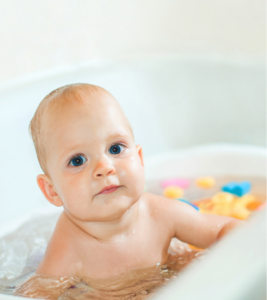 A lukewarm bath can provide comfort and gently help lower body temperature if your child is uncomfortable. Ensure the water is not cold, as that can cause shivering and drive the fever higher, and don’t make the bath too hot either. I like to add epsom salt to the bath, as well as calming essential oils, like lavender or chamomile.
A lukewarm bath can provide comfort and gently help lower body temperature if your child is uncomfortable. Ensure the water is not cold, as that can cause shivering and drive the fever higher, and don’t make the bath too hot either. I like to add epsom salt to the bath, as well as calming essential oils, like lavender or chamomile.
5. The Wet Sock Treatment
The Wet Sock Treatment is a simple home remedy that can help stimulate the immune system and improve circulation. To perform the treatment, soak a pair of thin cotton socks in cold water, wring them out, and place them on your child’s feet. Then, cover the wet socks with a pair of dry wool socks. The treatment works by encouraging blood flow.
To learn more about the wet sock treatment, and who it is suitable for, see: The Wet Sock Treatment: A Home Remedy For Colds & Flus
6. Homeopathy
Homeopathic remedies are a gentle and effective way to support the body through a fever without suppressing it. By selecting the right remedy based on your child’s overall symptoms, homeopathy can help speed up the healing process and provide comfort.
To learn more about specific remedies and how to use them, read my guide: Homeopathic Remedies for Fever Management.
Should Fevers Be Sweated Out or Cooled Down?
One of the common misconceptions surrounding fevers is the notion of “sweating it out” by bundling up a feverish child to induce sweating. This can actually be dangerous, as it may cause the fever to spike higher, leading to overheating or dehydration. Likewise, aggressively cooling a child with ice packs or cold baths can cause shivering, which can elevate their core temperature further as the body attempts to compensate.
The best approach is to find a middle ground:
- Light Clothing: Dress your child in light, breathable clothing. If they feel cold, provide a light blanket, but avoid bundling them up excessively.
- Room Temperature: Keep the room at a comfortable, moderate temperature. Avoid making the room too hot or too cold.
- Lukewarm Compresses: If your child is uncomfortable, use lukewarm or comfortably cool compresses on their forehead or neck to provide relief. Cold compresses are not recommended.
The goal is to support your child’s natural temperature regulation rather than forcefully reducing or increasing their temperature.
Febrile Seizures: What You Need to Know
For many parents, the possibility of febrile seizures during a fever is a source of significant worry. It is important to know that while febrile seizures can be frightening, they are typically harmless and don’t cause lasting damage or developmental issues. Many doctors find that febrile seizures seem to be triggered by the rapid onset of a fever, rather than how high the fever is, though the research on this is still unclear (10). Febrile seizures usually affect children between the ages of 6 months and 5 years (11), and if they occur, they usually occur within the first 24 hours of an illness/fever (11).
Can Febrile Seizures Be Prevented?
Unfortunately, febrile seizures can’t be reliably prevented using medication. However, you might be able to reduce the risk of a febrile seizure by keeping your child hydrated and comfortable during a fever and by avoiding bundling your child in heavy blankets, as this can trap heat and elevate their temperature further.
What to Do If Your Child Has a Febrile Seizure
- Stay Calm: Most febrile seizures last less than five minutes and do not cause permanent harm.
- Place Your Child in a Safe Position: Lay your child on their side on a soft surface, such as a bed or carpeted floor, to prevent choking or injury.
- Do Not Restrain: Do not try to hold your child down or stop the seizure, and never put anything in their mouth.
- Time the Seizure: If the seizure lasts longer than five minutes or if your child is not regaining consciousness after the seizure, seek medical help immediately.
While febrile seizures are typically harmless, always follow up with your pediatrician after one occurs, and in any instance where you are unsure or concerned, call for emergency help.
When to Medicate a Fever & When to Call a Doctor
While fevers are generally not dangerous, there are times when medical intervention is necessary. When it comes to fevers, we say: “treat the child, not the fever” — meaning that if a child is smiling and playing with a high fever, they are less worrisome than a miserable and listless child with a lower fever. That being said, here’s some tips on when to medicate using a fever lowering medication (ibuprofen or acetaminophen) and when to seek medical attention:
When to Medicate:
- Discomfort: If your child is so uncomfortable that their sleep and hydration is being affected and home care isn’t providing enough relief, it might be time to medicate.
- Fevers Below 103°F: Usually do not require medication unless your child is uncomfortable.
- Fever Over 104°F: While a fever of 104°F itself isn’t typically dangerous, at this point, it’s best to consider medication to bring down the fever or consult your doctor for advice.
When to Call a Doctor:
- Infants Under 3 Months: Any fever over 100.4°F in infants younger than 3 months requires immediate medical attention.
- Fever Lasting More Than 3 Days: Fevers that last longer than 72 hours, especially without improvement, should be evaluated by a doctor.
- Fever Over 104°F: If your child’s fever exceeds 104°F and does not come down with home care and/or fever reducing medication, or if it climbs rapidly, consult your doctor.
- Associated Symptoms: Seek immediate care if your child has difficulty breathing, persistent vomiting, severe headache, a stiff neck, light sensitivity, or is very lethargic.
- Sick Appearing Child: If your child is not acting like themselves (tired, not playing, irritable, excessively crying) or complaining of serious pain/discomfort speak to your doctor.
- Febrile Seizure: After a febrile seizure, even if brief, it’s a good idea to contact your doctor.
- Signs of Dehydration: If your child shows signs of dehydration (dry lips, sunken eyes, reduced urination, or extreme lethargy), contact your healthcare provider.
- Recurring Fevers: If your child experiences frequent, unexplained fevers, especially if they follow a regular pattern, consult your doctor to rule out underlying conditions like cyclic fever syndrome.
- Medication Doesn’t Help: If antipyretic medications like acetaminophen or ibuprofen don’t bring down a fever, consult your doctor.
A Note About Medicating Fevers: Ibuprofen vs. Acetaminophen
When it comes to reducing a fever, two common over-the-counter options are ibuprofen and acetaminophen. Both can be effective in providing relief, but they have distinct differences:
- Ibuprofen: Often recommended for its anti-inflammatory properties, ibuprofen can help reduce both fever and inflammation. It tends to last longer than acetaminophen (6-8 hours). However, ibuprofen should be avoided in infants under six months of age, and it should ideally be administered with food, as it may irritate the stomach lining. Ibuprofen should be avoided during pregnancy.
- Acetaminophen: This is commonly used for younger infants and provides fever relief. It is gentler on the stomach but lasts a bit less (4-6 hours). It is important to be aware that tylenol can cause liver damage and glutathione depletion if overused. Supporting the body with antioxidants like vitamin C, glutathione, and zinc can help protect the liver and maintain glutathione levels.
When choosing between these two, it’s important to consider your child’s age, symptoms, and overall health. Do not withhold medication if your child needs it.
To learn more, read these articles: Are Over-The-Counter Painkillers Safe?, Taking Tylenol? The Glutathione Connection, and Taking Ibuprofen? What You Need To Know To Protect Your Health
Fevers After Vaccination
It’s not uncommon for children to develop a mild fever after receiving a vaccine (12,13). This is usually a sign that the immune system is responding as expected, producing the necessary immune defenses to protect the body (12). Fevers following vaccination typically begin 12-24 hours after the shot and tend to resolve within 1-2 days. These fevers are generally low-grade and do not usually require medication (13). In most cases, providing comfort using the home care strategies outlined above is sufficient.
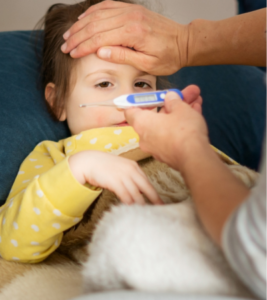 I don’t recommend giving fever-reducing medications like acetaminophen (Tylenol) prophylactically, even if your child has a history of febrile seizures. One reason for this is that acetaminophen can deplete glutathione, a powerful antioxidant that makes up an essential part of the body’s detoxification processes. Maintaining adequate levels of glutathione is important for managing the body’s response to any potential toxins vaccines might introduce (14,15,16).
I don’t recommend giving fever-reducing medications like acetaminophen (Tylenol) prophylactically, even if your child has a history of febrile seizures. One reason for this is that acetaminophen can deplete glutathione, a powerful antioxidant that makes up an essential part of the body’s detoxification processes. Maintaining adequate levels of glutathione is important for managing the body’s response to any potential toxins vaccines might introduce (14,15,16).
Additionally, research shows that by allowing the body to naturally respond to a vaccine without preventative anti-fever medicine, we support a healthy immune response (17,18). If a fever does arise, consider hydrating, resting, and using herbal supports before turning to fever-reducing medications. A fever after vaccination may simply indicate a concurrent infection, such as an upper respiratory infection. Monitor your child’s symptoms and contact your healthcare provider if you notice a fever above 102.2°F, persistent discomfort, or any other concerning symptoms.
Summary
Fevers are a natural part of the body’s immune response and often signal that the body is doing its job in fighting off infection. With the right home care — hydration, rest, herbal support, and more — you can help your child get through a fever comfortably.
It’s important to know when to allow the body to fight off infection and when to seek medical advice, particularly in the case of prolonged high fevers. By understanding the balance between allowing the fever to run its course and intervening when necessary, you can support your child’s healing with confidence.
References:
- Evans, S. S., Repasky, E. A., & Fisher, D. T. (2015). Fever and the thermal regulation of immunity: the immune system feels the heat. Nature reviews. Immunology, 15(6), 335–349. https://doi.org/10.1038/nri3843
- Rush. (n.d.). How the Body Regulates Heat. Www.rush.edu. https://www.rush.edu/news/how-body-regulates-heat
- Wrotek, S., LeGrand, E. K., Dzialuk, A., & Alcock, J. (2020). Let fever do its job: The meaning of fever in the pandemic era. Evolution, medicine, and public health, 9(1), 26–35. https://doi.org/10.1093/emph/eoaa044
- Wells W. A. (2006). Fever brings in the lymphocytes. The Journal of Cell Biology, 175(5), 678. https://doi.org/10.1083/jcb.1755rr4
- Balli S, Shumway KR, Sharan S. Physiology, Fever. [Updated 2023 Sep 4]. In: StatPearls [Internet]. Treasure Island (FL): StatPearls Publishing; 2024 Jan-. https://www.ncbi.nlm.nih.gov/books/NBK562334/
- Miraj, S., Rafieian-Kopaei, & Kiani, S. (2017). Melissa officinalis L: A Review Study With an Antioxidant Prospective. Journal of evidence-based complementary & alternative medicine, 22(3), 385–394. https://doi.org/10.1177/2156587216663433
- Drugs.com. (n.d.). Catnip Uses, Benefits & Side Effects – Drugs.com Herbal Database. https://www.drugs.com/npc/catnip.html
- Srivastava, J.K., Shankar, E., & Gupta, S. (2010). Chamomile: A herbal medicine of the past with bright future. Molecular medicine reports, 3(6), 895–901. https://doi.org/10.3892/mmr.2010.377
- Stępień, A.E., Trojniak, J., & Tabarkiewicz, J. (2023). Health-Promoting Properties: Anti-Inflammatory and Anticancer Properties of Sambucus nigra L. Flowers and Fruits. Molecules (Basel, Switzerland), 28(17), 6235. https://doi.org/10.3390/molecules28176235
- Berg, A.T. (1993). Are febrile seizures provoked by a rapid rise in temperature? Am J Dis Child. 1993 Oct;147(10):1101-3. doi: 10.1001/archpedi.1993.02160340087020. PMID: 8213683.
- Mount Sinai Health System. (n.d.). Febrile seizures Information | Mount Sinai – New York. https://www.mountsinai.org/health-library/diseases-conditions/febrile-seizures
- Zhuang CL, Lin ZJ, Bi ZF, Qiu LX, Hu FF, Liu XH, Lin BZ, Su YY, Pan HR, Zhang TY, Huang SJ, Hu YM, Qiao YL, Zhu FC, Wu T, Zhang J, Xia NS. (2021). Inflammation-related adverse reactions following vaccination potentially indicate a stronger immune response. Emerg Microbes Infect. 2021 Dec;10(1):365-375. doi: 10.1080/22221751.2021.1891002. PMID: 33583360; PMCID: PMC7928063.
- Das, R.R., Panigrahi, I., Naik, S.S. (2014). The effect of prophylactic antipyretic administration on post-vaccination adverse reactions and antibody response in children: a systematic review. PLoS One. 2014 Sep 2;9(9):e106629. doi: 10.1371/journal.pone.0106629. PMID: 25180516; PMCID: PMC4152293.
- James, S.J., Slikker, W. 3rd, Melnyk, S., New, E., Pogribna, M., Jernigan, S. (2005). Thimerosal neurotoxicity is associated with glutathione depletion: protection with glutathione precursors. Neurotoxicology. 2005 Jan;26(1):1-8. doi: 10.1016/j.neuro.2004.07.012. PMID: 15527868.
- Dringen, R., Brandmann, M., Hohnholt, M.C., Blumrich, E.M. (2015). Glutathione-Dependent Detoxification Processes in Astrocytes. Neurochem Res. 2015 Dec;40(12):2570-82. doi: 10.1007/s11064-014-1481-1. Epub 2014 Nov 27. PMID: 25428182.
- Khan, M. & Khan, Barkat, & Razaque, Ghulam & Haque, Naheed & Akhter, Basira & Zareen, Bakht. (2012). Evaluation of the Interaction of Aluminium Metal with Glutathione in Human Blood Components. Biomedical Research. 23. 237-240.
- Ahn, S.H., Zhiang, J., Kim, H., Chang, S., Shin, J., Kim, M., Lee, Y., Lee, J.H., Park, Y.R. (2019). Postvaccination Fever Response Rates in Children Derived Using the Fever Coach Mobile App: A Retrospective Observational Study. JMIR Mhealth Uhealth. 2019 Apr 22;7(4):e12223. doi: 10.2196/12223. Erratum in: JMIR Mhealth Uhealth. 2020 May 7;8(5):e18921. doi: 10.2196/18921. PMID: 31008712; PMCID: PMC6658305.
- Monfries, N., Goldman, R.D. (2017). Prophylactic antipyretics for prevention of febrile seizures following vaccination. Can Fam Physician. 2017 Feb;63(2):128-130. PMID: 28209678; PMCID: PMC5395384.
